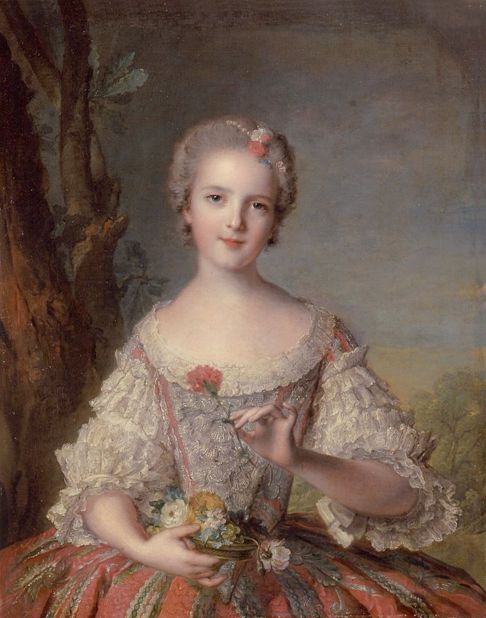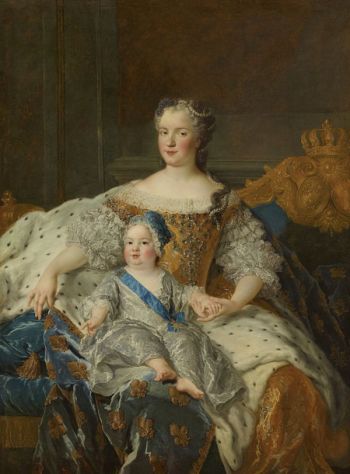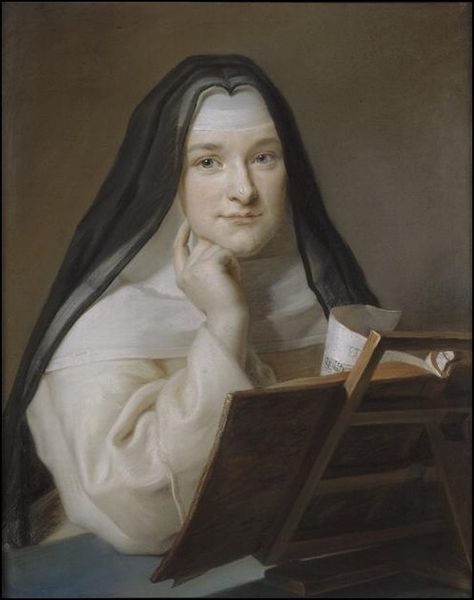By Plinio Corrêa de Oliveira
She fought the Revolution when she lived in the Court and later in the Carmel. She died poisoned by the revolutionaries, but her example continues to bear fruit to this day
Ed.: The author makes comments throughout the reading of the text on Princess Louise Marie of France. The English translation of the text being commented on is shown in quotes.]
Tomorrow, December 23, is the feast of the Venerable Therese of Saint Augustine, Virgin. There are copious data about her transcribed from “Les Vies des Saints et fêtes de toute l’année” by Fr. Daras, t. XII, Louis-Vivès Libraire-Editeur, Paris, 1856, Appendice – Vie de Madame Louise de France, 409-452:
“Princess Louise Marie de France, daughter of King Louis XV and Queen Maria Leczinska, Princess of Poland, was born in Versailles on July 15, 1737. She was educated at the abbey of Fontevrault, then run by Madame de Rochechouart.
“Still very young, she suffered an accident that almost cost her life. Impatient that her maid did not come at once to serve her, she climbed up the grate of her bed and fell. Although treated immediately, that fall brought her to the gates of death and left her with a physical deformity. On that occasion, the nuns of the monastery made a vow to the Virgin for the health of the princess and she was miraculously healed. She never forgot that she owed them her life, and that marked her in a profound way.

Venerable Louise-Marie of France; Portrait by Jean-Marc Nattier, 1748. She was declared Venerable in 1873 by Pope Pius IX.
“From childhood she showed an inclination to a life of piety and never got tired of the duration of the Divine Office. One day she wept bitterly because a lady servant told her about a foreign prince who would be her husband. However, she was proud of her position. On one occasion, feeling offended by one of her ladies, she said sourly, ‘Am I not the daughter of your king?’ And the lady answered, ‘And am I not, Madam, the daughter of your God?’ ‘You are right,’ replied the princess, touched by the answer; ‘I was wrong and beg your pardon.’
“She was extremely liberal with the poor ….”
Here, “liberal” means generous, open-handed.
“… On returning to court, she gave them the money received for her expenses, keeping nothing for herself. The maid in charge of her expenses became accustomed to giving the poor what she had received for Louise Marie, even without consulting her.
“Energetic in character, she enjoyed strenuous exercises. One day, hunting in Compiègne, her horse was startled and threw her at a reasonable distance. She fell almost under the wheels of a carriage travelling at great speed. Saved as if by a miracle, she laughed at the concern of her friends and commanded her squire to bring back her horse, mounted it, dominated the nervous animal and continued the ride. Back at the castle, she went to thank the Virgin for what she called the second salvation of her life.”

The virtuous Dauphin Louis, son of Louis XV and father of Luis XVI, Louis XVIII and Charles X (the last Kings of France). Painting by Anne Baptiste Nivelon.
“Wishing to enter the convent, while attending the Countess of Rupelmonde’s reception of the habit at the Carmel, she decided to join that Order. She began to prepare herself for it by studying the rule of St. Teresa and slowly abstaining from the comfort that surrounded her. She would stay away from the heated area of the castle during periods of appalling cold.”
“She could not stand the smell of candles and only overcame this repugnance after years of effort. Finally, she obtained the consent of the king and on February 20, 1770, entered the Carmelites of Saint Denis. France admired her example, and Pope Clement XIV wrote the princess to express his happiness at seeing his pontificate marked by such a comforting event for religion.”
Therefore, this event took place nineteen years before the French Revolution broke out.
“In the convent, she fought hard for her companions to stop distinguishing her from the others. She also worked to overcome her difficulty in staying a long time on her knees, a grace she obtained after a novena to St. Louis Gonzaga. She received the habit on September 10, 1770, clad in the mantle of Saint Teresa, owned by the Carmelites of Paris, and took the name of Sister Therese of Saint Augustine.”
What an honor to receive the habit clad in the mantle of Saint Teresa!
“Later named mistress of novices, she excelled in that difficult work, manifesting constant joy in the midst of the difficulties she encountered. Later she was unanimously elected mother superior. When the Visitor General of the Carmelites brought the news to the king, he said that Sister Therese had only had one vote against her. ‘So,’ Louis XV replied, ‘was there a vote against her?’ ‘Yes, Sire,’ answered the prelate, ‘but it was her own vote.’”
“As mother superior, she was full of charity towards her sisters and extremely stern with herself, seeking to follow the spirit of her rule with the utmost fidelity. She was also concerned to obtain from her father, and later from Louis XVI all the benefits she could for religion. It was she that welcomed into France the Carmelites from southern Austria expelled by Joseph II. Sister Therese also contributed to the foundation of a monastery of strict observance for the Discalced Carmelites, whose rule had become lax for some time. While severely forbidden to use her influence for anything that referred to worldly matters, she nevertheless used as much as she could for the salvation of souls….
“While keeping a distance from affairs of State, she remained deeply interested in its needs and sought to remedy them with prayers. She prayed for her father, for the preservation of faith in the kingdom, the restoration of customs, the salvation of peoples, public peace and tranquility. She had for the French the same love as her ancestor Saint Louis. Everything that interested her country interested her piety as well. Louis XVI revered her as the patron angel of France. Undoubtedly, it was to remove the influence she exerted on Louis XVI that the impious decided to exterminate her once and for all. It is almost certain that Marie Louise was poisoned to death.”
This point is extremely important. Two years before the French Revolution,
“In November 1787, her stomach illness became extremely serious, with sharp pains. From then on … she gradually got worse and prepared to die. Her death was magnificent because of the courage with which she faced it. Her last words were, ‘It’s about time, let’s go! Let us rise, let us hurry to Paradise.’ It was December 23, 1787, at four-thirty in the morning….
“Madam Louise de France has left the steps of the throne for God’s sake. Let us hope that in return He will one day raise her up on our altars.”
Blessed Pope Pius IX introduced the beatification process of Sister Therese of St. Augustine and declared her “venerable” in 1873. This process was resumed in Rome on December 13, 1985. The decrees on her heroic virtues were published on December 18, 1997. To be declared blessed it is necessary to have one well-documented miracle, recognizing that the eminent grace was obtained through her intercession.
To Be Continued…









